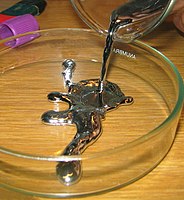
Photo from wikipedia
The removal by electrochemical treatment in batch of humic acids (HA) extracted from leonardite has been analyzed using aluminum electrodes at 25°C and neutral pH, under galvanostatic conditions. HA removal,… Click to show full abstract
The removal by electrochemical treatment in batch of humic acids (HA) extracted from leonardite has been analyzed using aluminum electrodes at 25°C and neutral pH, under galvanostatic conditions. HA removal, inferred from UV-Vis spectra and total organic carbon determination, occurred within few minutes of treatment under the experimental conditions tested, and no electrode passivation was observed. The removal rate increased with NaCl concentration and electric current density. Our data indicate that energy consumption per unit weight of HA removed can be significantly reduced by operating at low current density under galvanostatic conditions and/or high salt concentration, thus confirming electrochemical treatment as a powerful technology for wastewater treatment.
Journal Title: Journal of Chemistry
Year Published: 2019
Link to full text (if available)
Share on Social Media: Sign Up to like & get
recommendations!